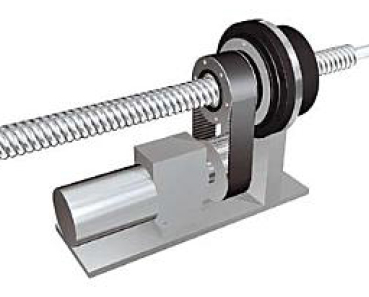In a recent post, we discussed using ball screw supports as a way to overcome the tradeoff between long travel length and high speed in ball screw applications. Responding to that post, several readers pointed out another solution to overcome the length-speed limitations of ball screws – rotating the ball nut rather than the screw itself.
Benefits
In a standard ball screw application, a motor rotates the screw, causing the ball nut to travel along the length of the screw. The main limitation of a driving the ball screw is that the screw naturally sags in the middle due to its own weight. As its rotational speed reaches what is known as the critical speed, the screw begins to develop a jump-rope type motion, known as whipping. Ball screw supports effectively reduce the unsupported length of the screw, allowing it to rotate at higher speeds before whipping occurs. Alternatively, driving the ball nut and keeping the screw stationary means that critical speed is no longer a factor, and high speeds can be achieved without adding ball screw supports.
Driving the ball nut also gives the benefit of reducing the system inertia, since only the ball nut is rotating, and not the entire ball screw. This means that a smaller motor can typically be used in a rotating nut application than in a similar rotating screw application. The mounting of a stationary screw also eliminates the need for support bearings for the screw journals, allowing the screw to be mounted under slight tension. This improves axial rigidity and increases the buckling load that can be applied. To further reduce stresses on the ball screw, it can be drilled for internal cooling to reduce the expansion and contraction effects of temperature changes.
How It Works
There are two methods of driving the ball nut – through a belt and pulley system, or with a hollow-shaft motor. When a belt and pulley system is used, the ball nut is supported by a radial bearing and the pulley is attached directly to the face of the ball nut. Many ball screw manufacturers offer a version of their ball nut product line with the support bearing mounted and an interface for the pulley. And in some cases, the complete assembly – including the belt and pulley system – can be sourced from the screw manufacturer. This greatly reduces the number of parts the user has to source and the time required to assemble them into the machine.

A hollow shaft motor eliminates these additional components by integrating the ball nut directly into the rotor. However, this requires that the motor be designed for ball nuts of a certain size range and dimensional standard (DIN, JIS, etc.). This makes the hollow shaft motor a more specialized solution and less common than belt and pulley systems for applications requiring a driven ball nut.

Ball Screw Supports or Driven Ball Nut?
If both solutions – ball screw supports and driven ball nut – provide the travel length and speed that your application requires, how do you choose the best option? The final decision may come down to ease of design and space considerations. In a system with a ball nut driven by a belt and pulley, the entire motor and belt-pulley system moves along with the ball nut. This means that their physical footprint must be taken into account when designing the surrounding machine components, to ensure there are no “crash” zones between the motor-pulley assembly and the machine. The hollow shaft motor is a more compact solution, but it requires finding a motor than can accept the selected ball nut and also deliver the speed and torque needed for the application. While ball screw supports are readily available and don’t involve complicated design modifications, they can take up a significant amount of the travel length, requiring an even longer ball screw to achieve the desired travel.
With a variety of design options to meet both travel and speed requirements, users and machine builders can find a ball screw solution that meets their technical requirements and integrates easily into their machine.


Leave a Reply
You must be logged in to post a comment.